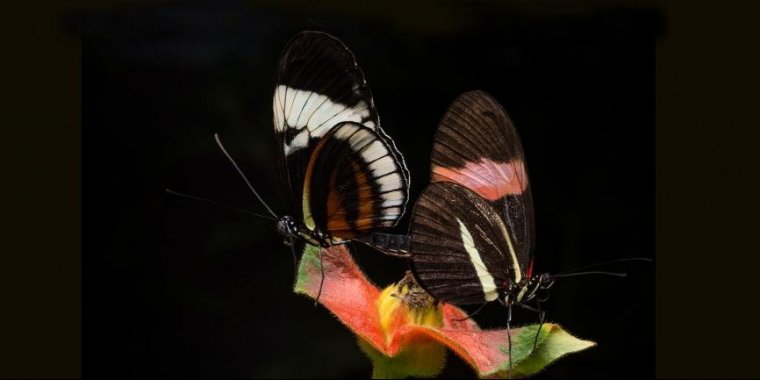| News / Science News |
Male butterflies mark their mates with a repulsive smell during sex to ‘turn off’ other suitors
Butterflies have evolved to produce a strongly scented chemical in their genitals, which they leave behind after sex to deter other males from pursuing their mates.

Two butterflies mating in captivity. Heliconius cydno (left) and Heliconius melpomene (right). Photo: Luca Livraghi
Led by Professor Chris Jiggins in the University of Cambridge's Department of Zoology, the team mapped production of the scented chemical compound to the genome of a species of butterfly called Heliconius melponene, and discovered a new gene.
They also discovered that the chemical, made in the sex glands of the males, is identical to a chemical produced by flowers to attract butterflies. The study shows that butterflies and flowers independently evolved to make the same chemical for different purposes.
Dr Kathy Darragh, lead author of the paper and previously a member of Jiggins' research group, said: “We identified the gene responsible for producing this powerful anti-aphrodisiac pheromone called ocimene in the genitals of male butterflies. This shows that the evolution of ocimene production in male butterflies is independent of the evolution of ocimene production in plants.
“For a long time it was thought insects took the chemical compounds from plants and then used them, but we have shown butterflies can make the chemicals themselves – but with very different intentions. Male butterflies use it to repulse competitors and flowers use the same smell to entice butterflies for pollination.”
There are around 20,000 species of butterflies worldwide. Some only live for a month, but the Heliconius melponene butterflies found in Panama that were studied live for around six months.
The females typically have few sexual partners and they store the sperm and use it to fertilise their eggs over a number of months after a single mating.
Male butterflies have as many mates as they can and each time they transfer the anti-aphrodisiac chemical because they want to be the one to fertilise the offspring. This chemical, however, is not produced by all Heliconius butterflies. Whilst Heliconius melpomene does produce ocimene, another closely related species that was analysed – Heliconius cydno – does not produce the strong smelling pheromone.
If the smell has such a powerful effect, how do the butterflies know when to be attracted or when to steer clear?
Darragh, now based at the University of California, Davis, explained: “The visual cues the butterflies get will be important – when the scent is detected in the presence of flowers it will be attractive but when it is found on another butterfly it is repulsive to the males – context is key.”
This new analysis of the power of smell – also called chemical signalling - sheds new light on the importance of scent as a form of communication.
Jiggins said: “The butterflies presumably adapted to detect this chemical to find flowers, and then evolved to use it in this very different way. The males want to pass their genes onto the next generation and they don’t want the females to have babies with other fathers, so they use this scent to make them unsexy.
“Male butterflies pester the females a lot so it might benefit the females too if the smell left behind means they stop being bothered for sex after they have already mated.” (University of Cambridge)
YOU MAY ALSO LIKE





